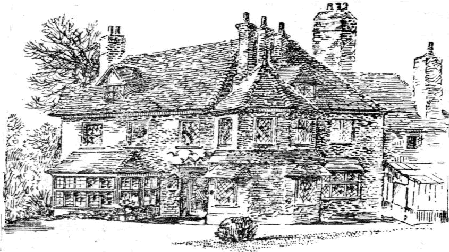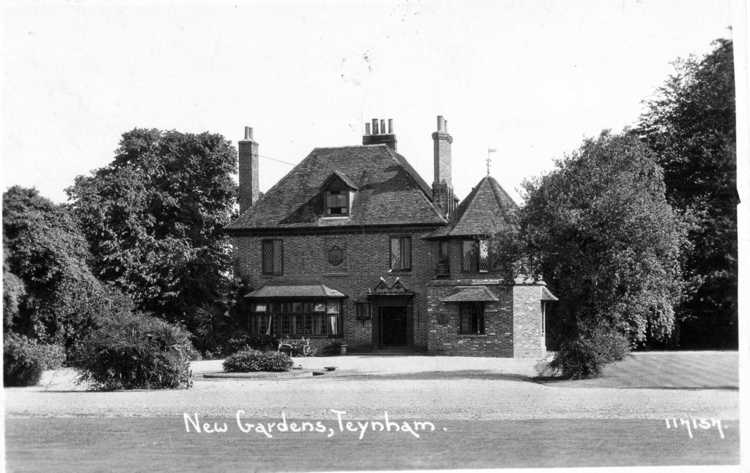“Newgardens”

This striking brick house, as we all knew it, set in wonderfully landscaped surroundings displaying many types of beautiful flowers, trees and bushes, encompassed by a tall brick wall was built in the 16th Century. The house had all the distinctive features of that period and was well maintained. It is believed that one of its first occupants was Richard Harrys, fruiterer to King Henry the Eighth. This gentle man, as we all know, was responsible for introducing and planting the first cherry and apple orchards in England on land attached to the house. At that time this area was known as “Teynham Outlands”, being in the outlying part of the then Archbishop’s Manor. The house became named “Newgardens” after these orchards were established. Lord Teynham was also a former owner/occupier.

Photographs kindly
supplied from the David Mann Collection.
The first time that the name “Honeyball” is recorded as being connected with the property is in the 1851 census. Frederick Honeyball, 39, occupation farmer, is shown as being resident there with his first wife Sophia, 29, son James aged 2 and daughter Louisa at 5 months, both children being born there. Later records show that in 1861 both he and his new wife, Ellen, daughter Louisa, aged 10, son Frederick aged 4, daughter Ellen aged 2 and son Frank just 7 months, were in residence. His first wife, Sophia, James’ mother, died in December 1852 at the age of 31 when James was just 3 years old. With the exception of Louisa, the remaining children were James’ stepbrothers and stepsisters. Later in 1871, the family residing at “Newgardens” consisted of Frederick, Ellen, Louisa, Frank and a new daughter Minnie aged 8. It is interesting to note that at this time James, 22, Frederick (Jnr.) 14 and Ellen 12 were not at the house. Maybe they were away at a residential school or on holiday. Reaching 1881 the entire family were back in the fold. James and Frank are shown as working in the family business and Frederick as an Estate Agent. By 1891, the children, Frederick, Ellen and Frank were living elsewhere, Ellen having married in October 1886 to Arthur Meers at the age of 27. Frederick Honeyball died in April 1895 at the age of 83 and his wife Ellen in June 1902 aged 71. She was living in Highgate, London at the time, having presumably moved away when stepson James and his wife, Olympia bought the house and became its occupants from 1899. Frederick Jnr went on to marry and have two daughters, Muriel and Doris and a son Wilfred. Frank married and became the father of two daughters.
Louisa died at the age of 66 in 1916, not having married. Minnie married Edward Kelly in April 1894 when 31 years old.
It is with the progress of James and Olympia’s activities in the Parish, emanating from their occupancy of “Newgardens”, that the older people of Teynham are most familiar and associate with their fondest memories. To complete the family history of the “Honeyballs” at “Newgardens” we must record the birth of James and Olympia’s first son James Frederick Martyn Herne in June 1901 and Lawrence Leigh Kempthorne, the second son, in July 1902, both at “Newgardens”.
During their time at the house, the couple became very much involved in local activities. James continued to work in the family coal business with its headquarter at 27 High Street, Sittingbourne and the coal store at the railway station at Teynham, with his brother Frank working alongside him. He was also Chairman of Teynham Parish Council, on the Committee of the National Deposit Friendly Society, served on the Board of the School Managers and became a Director of the Co-operative Brickmaking Society.
Meanwhile his wife Olympia served on the Committee of School Managers, was President and Treasurer of the Committee for the YMCA hut and Committee member of the Norton, Teynham and Lynsted District Nursing Association. She was a Teynham Parish Councillor until 1931, though records do not show when she was elected. So as has previously been stated, both James and Olympia spent a great deal of their time in working for the benefit of the Community as well as following their personal pursuits.
As is well known the Duke of York visited “Newgardens” in July 1921 when the cherries would have been at their best and Princess Helena Victoria came in April 1920 to officiate at the re-opening of the YMCA hut kindly initiated by the Colonel. Whilst Mrs. enjoyed being chauffeur driven around the parish in her car, Mr. spent much time doing the same thing but in his pony and trap. Maybe it is the memories of these events that remind us of the Honeyballs and “Newgardens”, names which will always conjure up discussion with the older members of the parish, and remain forever, as being the heart of the community over that period of time.
Bernard Cork